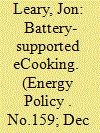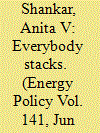|
|
|
Sort Order |
|
|
|
Items / Page
|
|
|
|
|
|
|
| Srl | Item |
| 1 |
ID:
181764


|
|
|
|
|
| Summary/Abstract |
Globally, 2.6 billion people still cook with biomass, resulting in interlinked health, environmental and drudgery challenges. The uptake of improved biomass cookstoves has barely kept up with population growth, yet SDG7 hopes for universal access to modern energy by 2030. This paper explores a potentially transformative new approach to facilitate access to affordable, reliable, sustainable and modern energy for cooking by leveraging rapid progress in electrification and falling prices of solar PV and lithium-ion batteries: battery-supported electric cooking. This paper presents empirical evidence on energy use, menu choices and cooking preferences from 83 households in 4 countries who transitioned from other fuels to electric cooking. A techno-economic model demonstrates that battery-supported electric cooking can be cost competitive with current expenditures on cooking fuels. No significant change in household menus occurred and the energy-efficient devices enabled 100% of everyday cooking with just 0.87–2.06 kWh/household/day. Our initial findings have already directly influenced the development of a 5-year UKAid-funded programme in collaboration with the World Bank, ‘Modern Energy Cooking Services’, and the new draft energy policy in Uganda. The paper concludes with two key policy recommendations: design lifeline tariffs inclusive of cooking and develop local markets for culturally-appropriate, quality-assured, energy-efficient cooking appliances.
|
|
|
|
|
|
|
|
|
|
|
|
|
|
|
|
| 2 |
ID:
175024


|
|
|
|
|
| Summary/Abstract |
Stove stacking (concurrent use of multiple stoves and/or fuels) is a poorly quantified practice in regions with ongoing efforts to transition household energy to cleaner options. Using biomass-burning stoves alongside clean stoves undermines health and environmental goals. This review synthesizes stove stacking data gathered from eleven case studies of clean cooking programs in low- and middle-income country settings. Analyzed data are from ministry and program records, research studies, and informant interviews. Thematic analysis identifiedy key drivers of stove stacking behavior in each setting. Significant (28%–100%) stacking with traditional cooking methods was observed in all cases. Reasons for traditional fuel use included: costs of clean fuel; mismatches between cooking technologies and household needs; and unreliable fuel supply. National household surveys often focus on 'primary' cookstoves and miss stove stacking data. Thus more attention should be paid to discontinuation of traditional stove use, not solely adoption of cleaner stoves/fuels. Future energy policies and programs should acknowledge the realities of stacking and incorporate strategies at the design stage to transition away from polluting stoves/fuels. Seven principles for clean cooking program design and policy are presented, focused on a shift toward "cleaner stacking" that could yield household air pollution reductions approaching WHO targets.
|
|
|
|
|
|
|
|
|
|
|
|
|
|
|
|
| 3 |
ID:
169853


|
|
|
|
|
| Summary/Abstract |
Nationwide transitions from cooking with solid fuels to clean fuels promise substantial health, climate, and environmental benefits. For decades, Ecuador has invested heavily in consumption subsidies for liquified petroleum gas (LPG), a leading clean fuel. With the goal of understanding household energy use in a context where LPG is ubiquitous and cheap, we administered 808 household surveys in peri-urban and rural communities in coastal and Andean Ecuadorian provinces. We assess cooking fuel ownership and use patterns after long-term LPG access and the reach of induction stoves promoted through a recent government program.
|
|
|
|
|
|
|
|
|
|
|
|
|
|
|
|
| 4 |
ID:
150360


|
|
|
|
|
| Summary/Abstract |
As part of a programme on ‘access to clean cooking alternatives in rural India’, induction stoves were introduced in nearly 4000 rural households in Himachal Pradesh, one of the few highly electrified states in India. Analysis of primary usage information from 1000 rural households revealed that electricity majorly replaced Liquid Petroleum Gas (LPG), generally used as a secondary cooking fuel, but did not influence a similar shift from traditional mud stoves as the primary cooking technology. Likewise, the shift from firewood to electricity as a primary cooking fuel was observed in only 5% of the households studied. Country level analysis indicates that rural households falling in lower monthly per capita expenditure (MPCE) classes have lesser access to electricity and clean cooking options than those falling in higher MPCE classes. Again, only three states in India with high levels of rural household electrification report consumption statuses more than 82 kWh per month (the estimated mean for electricity consumption by induction stoves). Overall, the results of the study indicate that induction stoves will have limited potential in reducing the consumption of firewood and LPG if included in energy access programmes, that too only in regions where high levels of electrification exist.
|
|
|
|
|
|
|
|
|
|
|
|
|
|
|
|
|
|
|
|
|